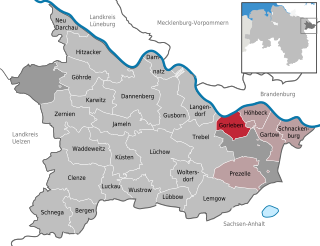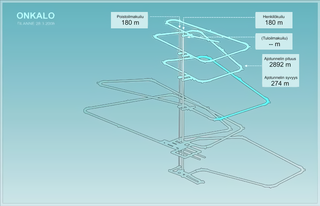
Radioactive waste is a type of hazardous waste that contains radioactive material. Radioactive waste is a result of many activities, including nuclear medicine, nuclear research, nuclear power generation, nuclear decommissioning, rare-earth mining, and nuclear weapons reprocessing. The storage and disposal of radioactive waste is regulated by government agencies in order to protect human health and the environment.

The Yucca Mountain Nuclear Waste Repository, as designated by the Nuclear Waste Policy Act amendments of 1987, is a proposed deep geological repository storage facility within Yucca Mountain for spent nuclear fuel and other high-level radioactive waste in the United States. The site is on federal land adjacent to the Nevada Test Site in Nye County, Nevada, about 80 mi (130 km) northwest of the Las Vegas Valley.

The nuclear fuel cycle, also called nuclear fuel chain, is the progression of nuclear fuel through a series of differing stages. It consists of steps in the front end, which are the preparation of the fuel, steps in the service period in which the fuel is used during reactor operation, and steps in the back end, which are necessary to safely manage, contain, and either reprocess or dispose of spent nuclear fuel. If spent fuel is not reprocessed, the fuel cycle is referred to as an open fuel cycle ; if the spent fuel is reprocessed, it is referred to as a closed fuel cycle.

A borehole is a narrow shaft bored in the ground, either vertically or horizontally. A borehole may be constructed for many different purposes, including the extraction of water, other liquids, or gases. It may also be part of a geotechnical investigation, environmental site assessment, mineral exploration, temperature measurement, as a pilot hole for installing piers or underground utilities, for geothermal installations, or for underground storage of unwanted substances, e.g. in carbon capture and storage.

Dry cask storage is a method of storing high-level radioactive waste, such as spent nuclear fuel that has already been cooled in the spent fuel pool for at least one year and often as much as ten years. Casks are typically steel cylinders that are either welded or bolted closed. The fuel rods inside are surrounded by inert gas. Ideally, the steel cylinder provides leak-tight containment of the spent fuel. Each cylinder is surrounded by additional steel, concrete, or other material to provide radiation shielding to workers and members of the public.

KBS-3 is a technology for disposal of high-level radioactive waste developed in Sweden by Svensk Kärnbränslehantering AB (SKB) by appointment from Statens Strålskyddsinstitut. The technology was developed by studying different natural storage facilities such as the natural reactor in Oklo, Gabon and the uranium mine in Cigar Lake, Saskatchewan, Canada. The general theory is that radioactive rock in these sites has been present for thousands of years, and has not affected the health and well-being of human populations. KBS-3 is also to be used in Finland at the Onkalo spent nuclear fuel repository, being built by Posiva.

The Waste Isolation Pilot Plant, or WIPP, is the world's third deep geological repository licensed to store transuranic radioactive waste for 10,000 years. The storage rooms at the WIPP are 2,150 feet underground in a salt formation of the Delaware Basin. The waste is from the research and production of United States nuclear weapons only. The plant started operation in 1999, and the project is estimated to cost $19 billion in total.
Ocean floor disposal is a method of sequestering radioactive waste in ocean floor sediment where it is unlikely to be disturbed either geologically or by human activity.

The Nuclear Waste Policy Act of 1982 is a United States federal law which established a comprehensive national program for the safe, permanent disposal of highly radioactive wastes.

A deep geological repository is a way of storing hazardous or radioactive waste within a stable geologic environment. It entails a combination of waste form, waste package, engineered seals and geology that is suited to provide a high level of long-term isolation and containment without future maintenance. This will prevent any radioactive dangers. A number of mercury, cyanide and arsenic waste repositories are operating worldwide including Canada and Germany and a number of radioactive waste storages are under construction with the Onkalo in Finland being the most advanced.

Gorleben is a small municipality (Gemeinde) in the Gartow region of the Lüchow-Dannenberg district in the far north-east of Lower Saxony, Germany, a region also known as the Wendland.
Deep borehole disposal (DBD) is the concept of disposing high-level radioactive waste from nuclear reactors in extremely deep boreholes instead of in more traditional deep geological repositories that are excavated like mines. Deep borehole disposal seeks to place the waste as much as five kilometres (3 mi) beneath the surface of the Earth and relies primarily on the thickness of the natural geological barrier to safely isolate the waste from the biosphere for a very long period of time so that it should not pose a threat to humans and the environment. The concept was originally developed in the 1970s, but in 2014, a proposal for a first experimental borehole was proposed by a consortium headed by Sandia National Laboratories.

High-level radioactive waste management concerns how radioactive materials created during production of nuclear power and nuclear weapons are dealt with. Radioactive waste contains a mixture of short-lived and long-lived nuclides, as well as non-radioactive nuclides. There was reportedly some 47,000 tonnes of high-level nuclear waste stored in the United States in 2002.

The Gorleben salt dome is a proposed deep geological repository in a salt dome in Gorleben in the Lüchow-Dannenberg district in the far north-east of Lower Saxony for low-, medium- and high-level radioactive waste.
From 1946 through 1993, thirteen countries used ocean disposal or ocean dumping as a method to dispose of nuclear/radioactive waste with an approximation of 200,000 tons sourcing mainly from the medical, research and nuclear industry.

The Onkalo spent nuclear fuel repository is a deep geological repository for the final disposal of spent nuclear fuel. It is near the Olkiluoto Nuclear Power Plant in the municipality of Eurajoki, on the west coast of Finland. It will be the world's first long-term disposal facility for spent nuclear fuel. It is being constructed by Posiva, and is based on the KBS-3 method of nuclear waste burial developed in Sweden by Svensk Kärnbränslehantering AB (SKB). The facility is expected to be operational in the mid 2020s.

A Blue Ribbon Commission on America's Nuclear Future was appointed by President Obama to look into future options for existing and future nuclear waste, following the ending of work on the incomplete Yucca Mountain Repository. At present, there are 70 nuclear power plant sites where 65,000 tons of spent fuel is stored in the USA. Each year, more than 2,000 tons are added to this total. Nine states have "explicit moratoria on new nuclear power until a storage solution emerges". A deep geological repository seems to be the favored approach to storing nuclear waste.
The Czech Radioactive Waste Repository Authority was established on 1 June 1997 as a state organisation established by the Ministry of Industry and Trade. In 2001, SÚRAO assumed the status of a government agency. The Authority is headed by its managing director, Dr. Jiří Slovák. The governing body of SÚRAO consists of its Board which is made up of representatives from the government, radioactive waste producers and the general public. The managing director and members of the Board of SÚRAO are directly appointed by the Minister of Industry and Trade.
The Underground Research Laboratory was a test site for deep geological repository of nuclear waste operated by Atomic Energy of Canada Limited's (AECL's) Whiteshell Laboratories near Lac du Bonnet in Manitoba, Canada. The site was built inside a large granite batholith, typical of the Canadian Shield. The site was selected in 1980, construction began in 1982 and it opened in 1985. No radioactive material was stored at the site, it was used purely for measurements of water exchange, rock movement, and other issues that would affect the safety of such materials. The site was also used by a variety of international users. As part of the wider wind-down of AECL activities, the decision was made to close the URL in 2003. Cleanup work began in 2006 and completed in 2010. The site continues to host a single international experiment measuring water leakage through a massive clay plug.













